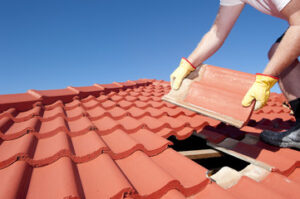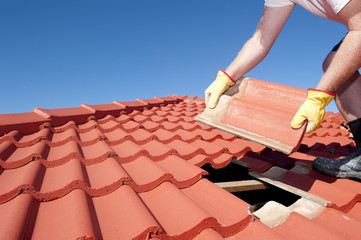Residential roofing protects and enhances a home’s structure while adding to its aesthetic appeal. There are many different options for residential roofing, including asphalt shingles, metal, and tile. Each has its benefits and drawbacks.
Residential roofs consist of rafters or pre-fabricated trusses and sheathing, usually plywood or oriented strand board (OSB). Sheathing is placed over the framing to add strength to the structure. Visit https://www.portcharlotteroofers.com/ to learn more.
Residential roofing can be a costly investment, but it’s one that can provide protection and increase the value of your home. There are a variety of materials to choose from, and the costs vary depending on the type and complexity of the project. Choosing the right materials and hiring a qualified professional can help you save money in the long run.
The cost of a residential roof can depend on its size, the material used, and the labor involved in the installation process. In general, asphalt shingle roofs are the most affordable option, while metal and tile roofs are more expensive. Additionally, the installation of special features such as skylights or chimneys can add to the overall cost of the roof.
Another factor that impacts the cost of a residential roof is the condition of the existing structure. A well-maintained roof should last 15-20 years, but if it’s in poor condition, you may need to replace it sooner. If you’re considering installing a new roof, it’s important to get estimates from several different roofing companies before making a decision. This will ensure that you’re getting the best price and quality for your budget.
The most common residential roofing materials include shingles, tiles, and metal. Shingles are a popular choice because they’re affordable, durable, and easy to install. They also come in a variety of colors and styles, which allows homeowners to customize their homes’ aesthetics. In addition to enhancing curb appeal, some roofing materials are more energy-efficient than others, which can lower your home’s heating and cooling costs.
Materials
The roof is a crucial part of your home, acting as the protective barrier that prevents moisture infiltration and protects the walls from rain or hail. It also helps convey your personal style and can add value to your property. There are several residential roofing materials to choose from, including asphalt shingles, metal and tile (clay or concrete). Each one has its own pros and cons, so you need to decide what’s best for your situation.
The most common residential roofing material, asphalt shingles are affordable and easy to install. They come in a variety of colors and styles to complement your home’s aesthetic. However, they don’t offer as much insulation as other roofing options. Additionally, asphalt shingles may have a shorter lifespan than other roofing materials.
Another popular option, wood shingles and shakes are made from natural cedar, redwood or pine. The rustic look pairs well with cottage, Cape Cod and Craftsman-style homes. Shakes are split into wedges for a more rugged look, while shingles are sawmilled for uniformity. Wood roofing is high maintenance, requiring regular cleaning and treatment with chemical preservatives and fire retardants. In addition, wood is flammable and is banned in areas with frequent wildfires.
Another option is clay tiles, which are handmade and fired for durability. They date back 5,000 years to glazed earthenware rooftops in China. They’re a good choice for warm climates, as they reflect the sun’s heat instead of absorbing it. However, they can be heavy and require extra structural support.
Installation
Residential roofing is the process of repairing and replacing the roof of a home. It is a complex project that requires the help of a qualified roofing contractor. There are a variety of factors to consider, including the type of materials, curb appeal, and environmental impact. Choosing the right materials is vital for a durable, long-lasting roof. Asphalt shingles are the most popular choice among homeowners, but metal and tile roofs also offer benefits. Many of these materials can reduce energy costs, while others have unique aesthetics that can enhance the look of a house.
The roof structure is the framework that supports the rest of the roof. It is usually made of rafters or trusses and defines the shape of the roof. Depending on the final roofing material, the roof structure may need to be reinforced to support the additional weight. It is also important to ensure that the roof is properly ventilated to prevent moisture buildup and mold growth.
Roof flashing is another essential component of a residential roof. This is installed around chimneys, air flow systems, and external piping to protect the underlying structures from water damage. Lastly, it is necessary to have a good drainage system for the roof to avoid pooling and puddling.
In addition to these considerations, homeowners should always research local building codes and regulations to ensure that their new roof is compliant with safety standards. This information is typically available from the local government or homeowners’ association. Additionally, it is important to cover landscaping plants so that they do not get damaged during the roofing process. It is also a good idea to remove vehicles and trash bins from the property so that they do not get in the way of the roofing crew.
Maintenance
Residential roofing provides protection from the elements and boosts a property’s aesthetic appeal. However, it requires regular maintenance procedures to extend its lifespan and ensure its performance. These procedures include conducting roof inspections and promptly addressing any issues. Regular inspections help identify potential problems early and prevent them from escalating into major issues that require costly repairs or replacement.
To conduct a roof inspection, homeowners should look for cracks, loose or missing shingles, and water damage. They should also check for proper draining, as clogged gutters can lead to puddles and water leaks. In addition, they should clean the surface of the roof to prevent moss and algae from taking hold. The inspection should also cover large accessories such as chimneys and skylights to prevent water penetration in these areas.
Roof maintenance should also include ensuring that all vents are working properly. These vents can help to regulate air temperature and humidity in the attic, which helps to reduce mold growth. In addition, they can also reduce energy costs by reducing the amount of heat that is transferred through the roof.
It is also important to keep a log of all maintenance activities performed on the roof. This will help homeowners, other roofing contractors, and future home buyers. It will also be helpful for filing warranty claims and demonstrating that the roof was well-maintained. A residential roof is one of the most significant investments a homeowner can make. Its longevity and durability are essential to a family’s health and safety, as well as the overall value of the property. Proper maintenance and inspections can extend its life and provide a solid return on investment.
Repair or replacement
Residential roofing is a type of roof designed for homes and other livable structures. It protects the occupants from harsh weather conditions and provides insulation to indoor living areas. It can be made from a variety of materials, including asphalt shingles, slate, wood, and metal. The type of material used will depend on the climate, architectural style, and personal preferences of the homeowner.
One of the biggest considerations for a residential roof is whether it should be repaired or replaced. This decision is based on a number of factors, including the age of the roof, damage extent, and budget limitations. It is important to weigh these factors carefully before making a decision. A professional roofing contractor can provide advice and guidance in this regard.
The most common residential roofing material is asphalt shingles, which are affordable and durable. They are available in a wide range of colors and styles and can enhance the curb appeal of a home. Another popular choice is slate, which is more expensive but has a long lifespan and requires very little maintenance. Other roofing materials include wood, which offers natural insulation and is fire-resistant, and metal, which is sturdy and easy to install.
A residential roof replacement project can be costly, but the right roofing company can help you save money by ensuring accurate measurements and minimizing waste. Moreover, they can also install energy-efficient materials that can significantly reduce heating and cooling costs.
During a roofing project, it is important to follow local regulations and building codes. This ensures that the project is completed according to industry standards and guarantees safety and durability for the structure. Additionally, it is a good idea to choose a local roofing company with a solid reputation and experience. You can start by asking for references from friends and neighbors or by looking at online reviews.
